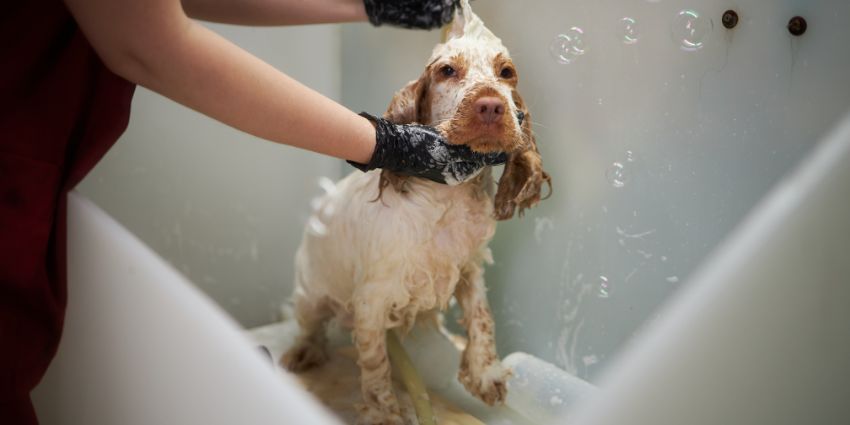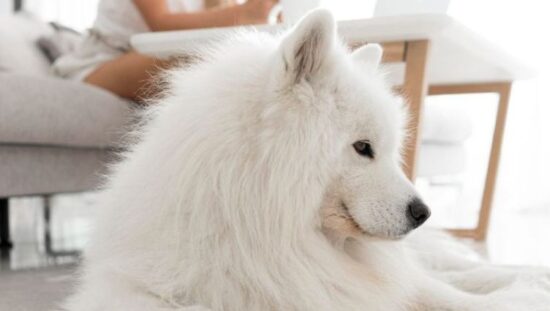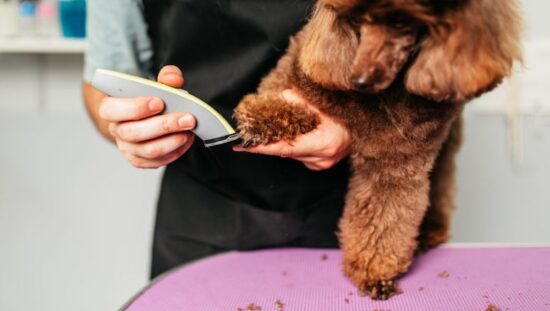If you have a white-furred friend, you know that maintaining their coat can be tough, particularly when battling stubborn brown stains. Whether your dog is prone to tear stains, saliva marks, or general outdoor adventures, we’ve got the solutions you need.
In today’s post, we’ll explore simple yet effective ways to get rid of tough stains without harming your pet.

Common Causes of Brown Stains on White Dog’s Fur
Several factors contribute to brown stains on white dog fur, and some of the most common causes include:
- Tear Staining – Brown stains are caused by tears running down the fur after overflowing in the eyes. It is prevalent in breeds with prominent eyes, such as Maltese, Poodles, and Shih Tzus. When the tears come into contact with the fur, porphyrin (a compound found in tears, saliva, and other bodily fluids of animals) can oxidize and create a reddish-brown color.
- Saliva and Food Stains – Dogs, particularly those with long hair, accumulate saliva around their mouths as they eat and drink. Additionally, food residue can stick to the fur and create stains. White fur makes these stains more visible.
- Dirt and Outdoor Elements – Dogs that spend a lot of time outside may pick up dirt, mud, or other substances that stain their fur. White fur is more susceptible to these environmental elements, increasing the likelihood of noticeable stains.
- Urine Stains – A dog’s urine can stain its fur, especially if it urinates on the belly or hind legs. White fur amplifies the visibility of these stains.
- Medical Conditions – Underlying health conditions, such as yeast or bacterial infections, can cause stains. It’s important to rule out any health concerns if staining persists despite efforts to keep the dog clean.
Safe Cleaning Agents for White Dog Fur
It is crucial to use safe cleaning agents to prevent irritation or harm to your pet. Several cleaning options are available, and the choice depends on the type of product you decide to use. Here, we will discuss the pros and cons of each product:
I. Specialized Dog Shampoos
Pros:
- Formulated for Dogs: Specialized dog shampoos are designed to meet the specific needs of canine skin and fur.
- Effective Stain Removal: Many dog shampoos remove stains, including tear and saliva stains.
- Varied Formulas: Available in various formulas to address specific issues like dry skin, allergies, or odor.
Cons:
- Cost: The cost of specialized shampoos may be higher than that of generic shampoos.
- Chemical Ingredients: Some products may contain chemicals that could irritate sensitive skin.
II. Natural Remedies:
Pros:
- Gentle on Skin: Natural remedies such as water mixed with apple cider vinegar or chamomile tea are gentle on the skin.
- Economical: Many natural remedies use common household items, making them cost-effective.
- Less Harsh Odor: Natural ingredients usually have a gentler fragrance in comparison to certain chemical-based products.
Cons:
- Effectiveness: The efficacy of natural remedies can differ, and they may not be as powerful as specialized products.
- Preparation Time: Some remedies require preparation, which may be less convenient than ready-to-use products.
III. Wet Wipes or Tear Stain Removers:
Pros:
- Convenience: Wipes are convenient for quick clean-ups and targeting specific areas like tear stains.
- Travel-Friendly: Ideal for on-the-go cleaning, especially when traveling with your dog.
- Mild Formulas: A lot of wipes are made with gentle ingredients that are good for delicate areas.
Cons:
- Limited Coverage: Wipes might not work as well for cleaning the whole body, especially for bigger dogs.
- Environmental Impact: Certain wipes might add to environmental waste, so think about using eco-friendly options.
Step-by-Step Guide to Removing Brown Stains
Make sure your furry friend looks bright and clean by following these simple steps:
- Identify the Stain Type
Take a closer look at the stain to determine its source, whether it’s tear staining, saliva, dirt, or another substance. Knowing what caused the stain helps you pick the right cleaning product.
- Prepare Your Dog
Gently secure your dog in a comfortable position, making sure they feel relaxed and safe. If needed, use treats or positive reinforcement to create a positive experience.
- Select a Suitable Cleaning Agent
Pick a cleaning product based on the identified stain type. You can use special dog shampoos, natural solutions, or tear stain removers. Just make sure whatever you choose is safe for your dog’s skin.
- Wet the Stained Area
Dampen the stained area with lukewarm water. Use a clean, soft cloth or cotton ball to make the fur around the stain damp. Don’t soak the fur too much.
- Apply the Cleaning Agent
Put the selected cleaning product on the stained spot. Follow the instructions on the product, or if it’s a homemade solution, make sure to apply it gently and evenly. Be careful around the eyes and other sensitive areas.
- Gently Massage the Fur
Use your fingertips to rub the cleaning product into the fur softly. Be gentle to avoid any discomfort for your dog. Massage the solution into the stained area to loosen the stain and ensure effective cleaning.
- Leave the Cleaner On
Follow the recommended duration for leaving the cleaner on the fur. This gives the cleaning product enough time to break down and remove the stain. Don’t leave the cleaner on for too long to avoid potential irritation.
- Rinse Thoroughly
Wash the stained area well with lukewarm water. Make sure you get rid of all the cleaning products. Thorough rinsing is important to stop any leftover product from causing skin irritation.
- Dry Your Dog
Softly dab the wet fur with a clean towel to take away extra moisture. If your dog is comfortable with it, you can use a hairdryer on a low, cool setting to speed up the drying process.
- Brush the Fur Again
Once the fur completely dries, take a soft brush and gently go through your dog’s coat. This helps get rid of any loose fur left and makes sure your dog looks smooth and clean.
Note: Keep an eye on your dog for any signs of discomfort, irritation, or allergies while and after cleaning. If irritation continues or gets worse, talk to your vet for advice on safe cleaning products and possible underlying issues.
Preventing Future Stains
There are a couple of things you can do to prevent future stains:
- Make sure to brush the fur regularly to remove loose hair and prevent tangles.
- If your dog tends to get stains near the eyes, use a wet cloth to clean that area and consider special wipes for tears.
- Wipe your dog’s mouth after eating to prevent stains from saliva and food.
- Give your dog a bath with a gentle shampoo regularly.
- Ensure your dog eats healthy food and drinks enough water for a good coat.
- Schedule regular check-ups with the vet to catch any health issues early.
- Limit your dog’s exposure to direct sunlight, since it can affect the color of their fur.
- Keep your dog’s living area clean by washing their bedding regularly.


